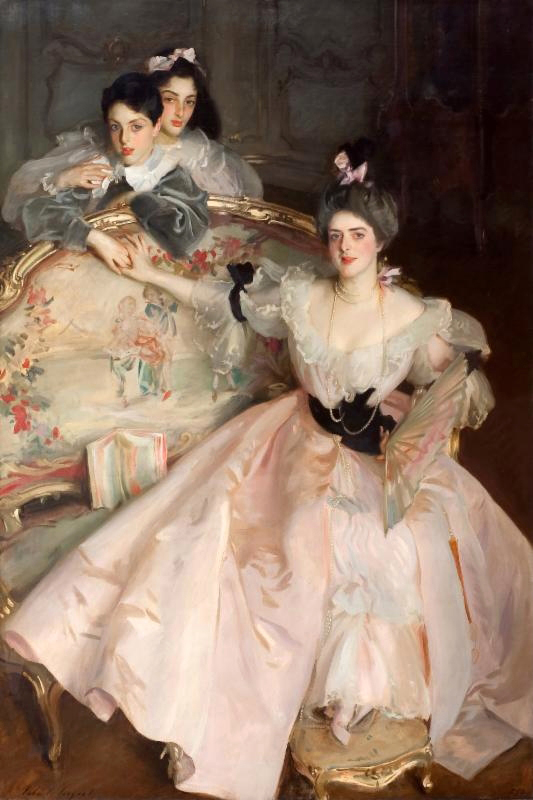
John Singer Sargent, “Mrs Carl Meyer and her Children,” 1896, oil on canvas. Tate: Bequeathed by Adèle, Lady Meyer 1930, with a life interest for her son and grandson and presented in 2005 in celebration of the lives of Sir Anthony and Lady Barbadee Meyer.
NEW YORK CITY — Few paintings by John Singer Sargent better exemplify his artistic prowess as a portraitist than “Mrs Carl Meyer and her Children.” Seductive and revealing, this bravura painting captures the world of a privileged family of Jewish origin in late Victorian England. On view at the Jewish Museum September 16–February 5, the painting will highlight this exhibit — contextualizing it with other family portraits, ephemera, documents, personal correspondence, and caricatures.
On loan from the Tate Britain, it has been over ten years since the painting was on view in the United States. The work depicts Adèle Meyer, a wealthy British philanthropist, well-known society hostess, and political activist, with her children, Elsie Charlotte and Frank Cecil.
When he painted the Meyer family in London in 1896, Sargent was the most sought after society portraitist in Britain and the United States. Within four years of its creation, the large-scale work (79 ½ by 53 ½ inches) was shown in three venues to popular and critical acclaim. The painting was a highlight of the Royal Academy’s exhibition in 1897. It was subsequently shown at the Copley Society of Boston in 1899, where it was considered one of the artist’s masterworks.
Sargent carefully staged his stylishly dressed sitters against Eighteenth Century French furniture and architectural elements. The animated Mrs. Meyer is posed just to the right of center at the edge of a canapé. She wears a dress of satin, velvet, and organdy possibly supplied by Worth in Paris. A rope of Oriental pearls drapes across her prominently featured bodice, touching the tips of her shoes. Sargent’s worms-eye view troubled some critics and left much room for sly commentary. One caricature in Punch, 1897, in which the two children struggle to keep their mother from falling off the sofa, was described as “a sort of drawing-room tobogganing exercise.”
In this work, as in many of Sargent’s portraits, the artist builds upon European masters such as Titian, Velázquez, and Gainsborough in his reinterpretation of grand manner portraiture.
In addition to Sargent’s “Mrs Carl Meyer and Her Children,” 1896, exhibition highlights include photo albums of the Meyer family from 1902 to 1909; the guest register for the family’s country seat, Shortgrove, Essex, from 1902 to 1930 which included composer Reynaldo Hahn and actress Sarah Bernhardt, among others; caricatures by Max Beerbohm; several of Carl Meyer’s seals; charcoal drawings by John Singer Sargent depicting Adele’s sister in 1909, and daughter, Elsie, in 1908, and more.
The curatorial team has created a virtual album, which will be viewable in the exhibition gallery on an iPad, of selected photographs from the Meyer family albums and collections. These capture details of life at their country home, Shortgrove, as well as their travels and theatrical pursuits.
Mrs. Carl Meyer (the former Adèle Levis, about 1861–1930) was the daughter of Julius Levis, a wealthy European rubber manufacturer, and his wife, Emily Levis (née Hecht). Adèle Levis married the banker Carl Ferdinand Meyer in 1883. He was born in Hamburg and became a naturalized British subject in 1877. He was a foreign emissary for the London branch of the Rothschild bank, representing their interests in some of the major financial negotiations of the time, and later became London chairman of the De Beers Company as well as director of the National Bank of Egypt. Carl Meyer was created Baronet of Shortgrove in 1910. A vivacious hostess and leader of the artistic society of the day, Lady Meyer was passionate about music and the performing arts. Her philanthropy was split between high culture and social cause, including women’s suffrage, conditions for female factory workers, and support for underprivileged families.
The Jewish Museum is at 1109 Fifth Avenue. For more information, www.TheJewishMuseum.org or 212-423-3200.




